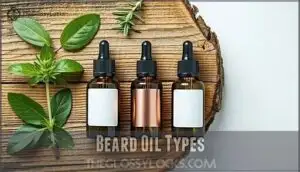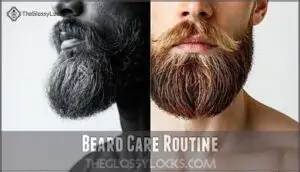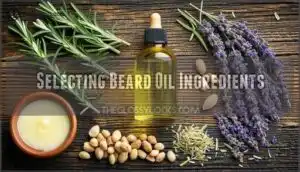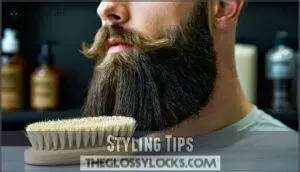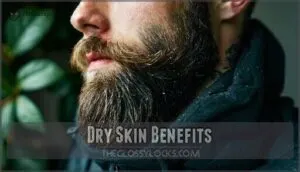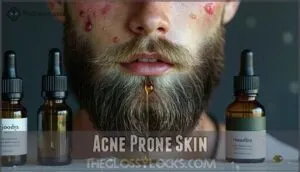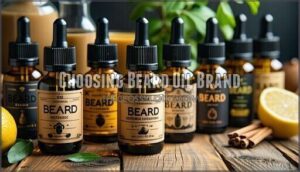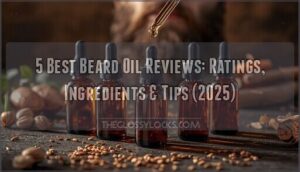This site is supported by our readers. We may earn a commission, at no cost to you, if you purchase through links.
 When learning how to choose beard oil, focus on your skin type and beard length first.
When learning how to choose beard oil, focus on your skin type and beard length first.
Dry skin needs heavier oils like argan or jojoba, while oily skin works better with lighter options like grapeseed.
Consider your beard’s texture—coarse hair requires more moisturizing ingredients, while fine hair needs lighter formulas to avoid weighing it down.
Check the ingredient list for natural carrier oils and avoid harsh chemicals.
Scent matters too; choose something that complements your lifestyle and won’t clash with cologne.
Start with smaller bottles to test compatibility before committing to full sizes.
The right oil transforms your beard from scratchy to smooth, but there’s more to mastering the perfect application technique.
Table Of Contents
Key Takeaways
- Match oil to your skin type – Choose lightweight oils like jojoba or grapeseed for oily skin, while dry skin needs heavier options like argan or coconut oil for proper moisturization.
- Consider your beard’s texture and length – Coarse, thick beards require more moisturizing ingredients, while fine hair needs lighter formulas to avoid weighing it down or looking greasy.
- Check ingredients and avoid harsh chemicals – Look for natural carrier oils in the ingredient list and steer clear of synthetic additives that can irritate your skin or damage your beard.
- Start small and test compatibility – Buy smaller bottles first to test how your skin reacts and whether you like the scent before committing to full-sized products.
Choosing Beard Oil
You’ll discover that choosing the right beard oil transforms your facial hair from scratchy mess to smooth perfection while keeping your skin healthy underneath.
The key lies in matching your skin type, preferred scent, and specific beard goals to find an oil that works with your unique needs rather than against them, which can be considered a complete approach to achieving smooth perfection.
Beard Oil Benefits
Beard oil benefits transform your facial hair game with serious perks.
You’ll get Hydration Boost for softer whiskers, Itch Relief that stops the scratching madness, and Dandruff Control to eliminate those embarrassing flakes.
This beard oil selection guide shows how quality beard oil ingredients promote Facial Health and Growth Stimulation, making your beard oil buying guide decisions easier.
Skin Types Consideration
Your skin type determines which beard oil formula works best for you.
Match your skin type to your beard oil formula for maximum results and comfort.
Different formulations target specific skin needs, so matching your skin’s characteristics guarantees maximal results and comfort.
Here’s how to match beard oil to your skin type:
- Oily skin – Choose lightweight, fast-absorbing oils like jojoba or grapeseed that won’t clog pores
- Dry patches – Select heavier oils like argan or coconut that provide deep moisturization
- Sensitive skin – Opt for hypoallergenic beard oil for sensitive skin with minimal ingredients
- Combination skin – Use balanced formulas with medium-weight carrier oils like sweet almond
- Normal skin – Most beard oil types work well, giving you flexibility in beard oil selection guide choices
Understanding your skin’s needs prevents irritation and maximizes the benefits of quality beard oil ingredients.
Fragrance Options
Fragrance options can make or break your beard oil experience, so don’t overlook this vital element.
Your personal preference drives the decision, but consider how scent profiles affect your daily interactions.
Essential oils offer natural aromas, while synthetic fragrances provide consistent intensity levels.
Always check for allergen concerns.
| Scent Category | Best For | Intensity Level |
|---|---|---|
| Woodsy/Cedar | Professional settings | Medium |
| Citrus/Fresh | Daily wear | Light to Medium |
| Unscented | Sensitive skin | None |
| Spice/Warm | Evening use | High |
| Floral/Herbal | Casual occasions | Light |
How to Choose Beard Oil

You’ll need to match your beard oil to your specific skin type and grooming goals for the best results.
The right choice depends on your skin’s oil production, sensitivity level, and whether you’re dealing with issues like dryness or irritation, to achieve the desired outcome with your beard oil.
Dean Flooring Company Expertise
When you’re exploring the beard oil marketplace, think of it like choosing flooring for your home – you need proven expertise and quality craftsmanship.
Dean Flooring Company’s decades of Manufacturing Process Details and Installation Service Quality translate into understanding what creates lasting results, whether it’s grip solutions or the best beard oil formulations that truly work.
The combination of these factors, including quality craftsmanship, is essential for achieving the desired outcome.
Superior Grip Technology Solutions
Modern beard oil bottles benefit from grip enhancement technology that prevents slips during application.
Surface adhesion improvements and material science advances create better bottle textures.
Friction reduction coatings help you control dispensing precisely, while durability testing guarantees long-lasting performance.
One can also see the benefit of improved control with these bottles.
When you choose the best beard oil, consider bottles with enhanced grip features for easier handling during your grooming routine.
Proven Safety Track Record
Beyond advanced technology, you need manufacturers with proven safety records and regulation compliance.
Look for brands that provide thorough ingredient testing, allergen information, and transparent user feedback from beard oil reviews.
Safe manufacturing processes and detailed beard oil comparison data help you avoid beard oil allergies while ensuring beard oil safety for your specific skin needs.
Beard Oil Types
You’ll encounter three main types of beard oil when shopping for facial hair care products.
Organic oils use natural ingredients, synthetic versions offer consistent performance, and blended formulas combine both approaches for balanced results, utilizing blended formulas.
Organic Beard Oils
Once you’ve narrowed your beard oil choices, organic beard oil stands out for its purity and eco-friendliness.
If you’re after a natural beard oil, look for:
- Organic Certification for peace of mind
- Transparent Ingredient Sourcing
- DIY Recipes for customization
- Sustainable Packaging options
- Benefits Analysis for your skin and beard
These oils can also function as organic pre-shave protection.
Choosing organic shows you care—about your face and the planet.
Synthetic Beard Oils
Synthetic beard oils contain artificial ingredients like mineral oil and parabens that deliver temporary smoothness but lack deep nourishing benefits.
While these cost-effective options offer extended shelf life and diverse beard oil scent varieties, potential irritants may cause skin reactions.
Consider exploring options for purchasing synthetic oils online, which can be a budget-friendly yet questionable choice for serious beard grooming enthusiasts due to their environmental impact, making them a choice that many users question because of potential skin reactions.
Blended Beard Oils
After weighing natural versus synthetic options, you’ll find blended beard oils offer the best of both worlds.
These custom blends combine carrier ratios that maximize benefits synergy while creating unique scent profiles.
When you choose blended formulations, you get oil combinations that address multiple beard concerns simultaneously.
This beard oil guide approach helps your selection process by offering versatility that pure oils can’t match.
Beard Care Routine
Your beard care routine determines whether your facial hair looks polished or unkempt, so establishing consistent daily habits makes all the difference.
You’ll want to integrate beard oil application with your regular grooming schedule, combining it smartly with cleansing and conditioning steps for maximum effectiveness, which is a key part of a consistent daily routine.
Daily Application
Since consistency creates the foundation for healthy beard growth, you’ll want to establish a reliable daily application routine.
Start with just 2-3 drops each morning after showering, when your beard’s slightly damp but not soaking wet.
- Morning application: Apply after showering when hair follicles are open and receptive
- Evening touch-ups: Add a single drop if your beard feels dry before bed
- Weekend maintenance: Increase to 4-5 drops for deeper conditioning on rest days
- Travel adjustments: Pack travel-sized bottles to maintain your routine anywhere
Combining With Shampoo
You’ll want to use beard shampoo before applying beard oil to prevent Oil Buildup and guarantee proper absorption.
Most beard grooming products work best when your facial hair is clean, so focus on gentle Lathering Technique and moderate Washing Frequency.
Check Shampoo Ingredients for harsh sulfates that strip natural oils, then follow with proper Post-Wash Care and beard oil application for superior beard maintenance results.
Conditioning Tips
After shampooing, your beard needs proper conditioning to maintain its health and appearance. Ideal Frequency for conditioning varies by beard type, but most men benefit from 2-3 times weekly.
Application Timing matters – apply conditioner on damp hair for better absorption.
- Pre-Wash preparation: Use beard oil application before conditioning to create a protective barrier
- Oil Combinations work best: Mix lightweight carrier oils with your conditioner for enhanced results
- Post-Wash care prevents dry beard: Apply leave-in conditioner to lock in moisture and prevent itchy beard
- Target problem areas: Focus extra conditioning on coarse sections to achieve that coveted soft beard texture
Selecting Beard Oil Ingredients
You’ll want to focus on three main ingredient categories when selecting your beard oil: natural oils, essential oils, and carrier oils.
Understanding these components helps you choose a formula that matches your skin type and provides the right balance of moisturizing, conditioning, and aromatic benefits.
Natural Oils
You’ll discover natural ingredients create the foundation for effective beard care, delivering pure nourishment without synthetic additives.
Sourcing ethics and oil extraction methods directly impact purity levels and unique properties.
| Natural Oil | Primary Benefits | Best For |
|---|---|---|
| Jojoba Oil | Mimics natural sebum, fast absorption | All skin types, beard health |
| Argan Oil | Deep moisturizing, reduces frizz | Dry, coarse beards |
| Avocado Oil | Vitamin-rich conditioning, non-greasy | Growth support, sensitive skin |
| Castor Oil | Promotes circulation, adds shine | Beard oil for growth, thickness |
Consider allergy concerns when selecting natural ingredients, especially if you’re sensitive to tree nuts or specific botanicals.
Essential Oils
Through careful selection of essential oils, you’ll discover beard oil’s therapeutic properties and scent profiles.
Different extraction methods produce varying quality levels, so choose reputable brands for beard health.
Consider these key factors:
- Oil combinations – blend complementary scents
- Safety concerns – patch test new essential oils
- Beard growth support – rosemary and peppermint stimulate follicles
To enhance follicle health, consider oils with Vitamin C and Biotin.
Carrier Oils
Carrier oils form the backbone of quality beard grooming products, determining Oil Properties like Absorption Rates and viscosity.
Jojoba and argan oils rank low on the Comedogenic Scale, preventing clogged pores while delivering nutrients.
Consider Scent Profiles and Shelf Life when building your beard care routine—lighter oils absorb faster, while heavier ones provide lasting moisture for your beard oil brands selection.
Applying Beard Oil Correctly
Once you’ve chosen the right beard oil, applying it correctly makes all the difference in achieving healthy, manageable facial hair.
You’ll want to master the proper amount, massage technique, and styling approach to get the most from your investment.
Amount to Apply
Determining your beard oil application starts with understanding your beard grooming needs and current grooming routine.
Most men need 3-6 drops for short beards, while longer facial hair requires up to 10 drops, depending on Beard Length and Oil Absorption rates.
- Application Frequency: Start with once daily, adjusting based on your skin’s response and beard oil usage instructions
- Beard Length: Short beards (under 1 inch) need 3-4 drops; medium beards require 5-7 drops; long beards need 8-10 drops
- Oil Absorption: Coarse hair absorbs more product than fine hair, affecting your beard care routine timing
- Skin Sensitivity: Sensitive skin requires less product initially to prevent irritation from beard grooming products
- Climate Impact: Dry environments increase absorption needs, while humid conditions reduce required amounts
Massage Techniques
Once you’ve applied the right amount of beard oil, work it through your whiskers using circular motions and upward strokes.
Focus on pressure points along your jawline while performing this facial massage – it stimulates blood flow and guarantees even distribution.
Tool usage isn’t necessary; your fingertips provide perfect control for effective beard massage and mens grooming.
Styling Tips
After mastering the massage, you’ll want to shape your beard for maximum impact.
Use styling tools like boar bristle brushes to distribute oil combinations evenly while controlling volume.
Work the beard oil through sections, taming flyaways with gentle downward strokes.
Focus on your desired beard shape, using beard grooming tips that enhance manageability and create definition for professional-looking results.
Proper grooming and maintenance are essential for a polished look and to achieve the desired beard shape.
Beard Oil for Skin Conditions
Your skin type plays a vital role in selecting the right beard oil formula for exceptional results.
Whether you’re dealing with dry patches, breakouts, or sensitivity, choosing an oil with targeted ingredients can transform your facial hair routine from frustrating to fantastic.
Dry Skin Benefits
Once you’ve nailed your beard oil routine, you’ll notice how much it helps with dry skin.
Beard oil for dry beards isn’t just hype—it’s real beard nourishment.
Here’s what you get:
- Hydration Improvement
- Itch Relief
- Flake Reduction
- Stronger Skin Barrier
- Winter Protection
Your skin will thank you, especially when the cold bites.
Using beard oil with ingredients like organic jojoba oil can further enhance these benefits.
Acne Prone Skin
If dry skin’s your nemesis, oily or acne-prone skin brings its own set of plot twists.
Pick non-comedogenic oils like jojoba or argan, and look for tea tree oil or salicylic acid for extra backup.
Always patch test to avoid irritation—your face isn’t a science experiment.
Check beard oil reviews, and seek beard oil recommendations for oily beards.
| Ingredient | Benefit |
|---|---|
| Jojoba Oil | Non-comedogenic, soothing |
| Tea Tree Oil | Fights acne, reduces redness |
Sensitive Skin
Sensitive skin requires a gentler approach when choosing beard oil for skincare.
Start with patch testing any new product on your inner wrist before applying to your face.
Look for hypoallergenic oils like jojoba or argan, which minimize ingredient sensitivity.
These soothing ingredients provide irritation relief without triggering reactions.
Avoid beard oil with strong fragrances or alcohol-based formulas that can worsen beard itch relief needs.
Choosing Beard Oil Brand
You’ll find success by focusing on brands with solid reputations and proven track records in beard care.
Reading customer reviews helps you spot which products actually deliver on their promises, while comparing prices guarantees you get quality without overpaying.
Reputable Brands
Looking for trusted beard oil brands means focusing on Brand Reputation and proven track records.
You’ll want brands that prioritize Ingredient Quality through transparent formulations and Ethical Sourcing practices. The best beard oil companies combine Brand History with modern grooming innovations.
Here are four reputable brands worth considering:
- **Black Rebel Beard Co.
** – Top-rated in 2025 for premium scent variety and advanced nourishing formulas
- Live Bearded – Popular for lightweight, fast-absorbing oils with distinctive fragrances
- Jack Black – Known for antioxidant-rich blends with marula and plum oils
- Proraso – Over a century of European personal care craftsmanship and quality
Many consumers explore various beard oil options before settling on a preferred brand.
Customer Reviews
Three simple rules help you separate authentic feedback from fake reviews when choosing beard oil.
First, check Review Authenticity by looking for verified purchases and detailed experiences rather than generic praise.
Second, examine Rating Accuracy by reading recent reviews since older feedback may not reflect current product quality.
Third, consider Influencer Opinions alongside regular customer sentiment analysis to get balanced perspectives on your beard oil selection from multiple alternatives and options.
Many users find that jojoba seed oil helps moisturize effectively.
Price Comparison
Budget-conscious buyers can find quality beard oils between $10-$30, with ingredients impacting price substantially.
Premium organic options cost more than synthetic alternatives, but value vs. cost matters most.
Brand name pricing varies widely – compare oil volume pricing across selection criteria.
Consider long-term savings when you choose between options, as larger bottles often reduce per-ounce costs for regular users, focusing on the total cost.
Maintaining Beard Health
You’ll get the best results from your beard oil when you pair it with proper overall beard maintenance.
Beyond selecting the right oil, your facial hair needs consistent trimming, proper nutrition, and adequate hydration to look its absolute best.
Regular Trimming
Regular trimming keeps your beard looking sharp and prevents split ends that can make even premium beard oil less effective.
Choose your trimming frequency based on growth rate—typically every two to three weeks works well.
For shaping styles, invest in quality maintenance tools like sharp scissors and adjustable clippers. DIY trimming saves money, but consider professional trims quarterly for complex shapes.
Regular maintenance prevents beard dandruff and guarantees your oil selection penetrates evenly, matching your unique growth pattern and desired style options. Your criteria for trimming frequency should match your beard’s growth rate.
Balanced Diet
Your beard’s foundation starts from within – proper nutrition directly impacts hair follicle strength and growth.
Focus on protein-rich foods, healthy fats, and vitamins A, C, and E for superior beard health.
Meal planning guarantees consistent nutrient absorption, while portion control prevents dietary imbalances.
Incorporate beard-friendly healthy recipes featuring salmon, nuts, and leafy greens.
Remember, beard oil for beard growth works best when supported by solid nutritional habits that fuel your facial hair from the inside out.
Hydration Tips
Water matters more than you think for your beard’s health. Drinking eight glasses daily keeps your skin hydrated from within, preventing the dryness that makes beards scratchy.
Adding a humidifier to your room creates moisture that benefits both skin barriers and beard softness. Foods like watermelon and cucumber boost hydration naturally.
When you avoid dehydration, your beard oil works better, improving beard appearance and manageability while maintaining ideal beard hydration.
Frequently Asked Questions (FAQs)
How do I know what beard oil to use?
Looking for the perfect potion isn’t just about scent—your beard’s like a garden that needs the right nutrients.
Consider your skin type, beard length, scent preferences, and ingredient quality when selecting oil for superior results.
What is the rule 5 for beards?
Currently thinking about washing your beard regularly.
Texas Beard Company emphasizes that you absolutely must wash your beard at least once weekly, preventing bacterial infections that damage follicles while maintaining cleanliness.
They also highlight the importance of maintaining cleanliness to prevent damage to the beard.
What is the best oil for beard?
You’ll want to focus on jojoba and castor oil as two of the most widely used carrier oils, along with argan, and sweet almond oils for ideal beard health.
Argan oils, baobab and jojoba help reduce itchiness or flakiness while softening coarse hair effectively.
How long does beard oil typically last?
Beard oil typically lasts 2-4 hours on your skin and hair before needing reapplication. You’ll notice the effects fade as your beard starts feeling dry again throughout the day.
Can beard oil expire or go bad?
Yes, beard oil can expire and go bad.
Most oils last 1-2 years, but check for rancid smells, texture changes, or separation.
Natural oils without preservatives spoil faster than synthetic blends.
Whats the difference between beard oil and balm?
Oil is liquid and absorbs quickly into your beard hair and skin, providing lightweight moisture. Balm is thicker with wax, offering hold and styling control while moisturizing.
How often should I wash my beard?
Don’t worry about overwashing – it’s actually more damaging than underwashing.
Wash your beard 2-3 times weekly with specialized beard shampoo, not regular shampoo which strips natural oils and leaves your facial hair brittle.
Does beard oil help with beard growth?
Growth isn’t the primary benefit here.
Beard oil moisturizes your skin and facial hair, reducing itchiness and flakiness.
While healthy, conditioned follicles might support better growth, don’t expect dramatic results from oil alone, as it primarily aids in moisturizes.
Conclusion
Ready to transform your grooming game forever? Mastering how to choose beard oil isn’t complicated once you understand your skin’s needs and beard’s texture.
Match heavy oils to dry skin, lighter formulas to oily complexions. Test small bottles first, check ingredient lists carefully, and consider scent compatibility with your lifestyle.
The perfect beard oil eliminates itchiness, promotes healthy growth, and leaves your facial hair manageable. With consistent application using proper techniques, you’ll achieve the smooth, well-groomed beard you’ve always wanted, and enjoy a well-groomed lifestyle.
- https://beardgains.com/blogs/learn/best-beard-oil
- https://thebeardclub.com/blogs/beard-culture/beard-oil-the-comprehensive-guide
- https://us.typology.com/library/how-to-choose-a-beard-oil
- https://usenoble.com/blogs/news/a-beginner-s-guide-to-choosing-the-right-beard-oil-for-your-grooming-needs
- https://www.beardorganics.com/blogs/beard-blog/what-are-the-best-ingredients-for-beard-oil

